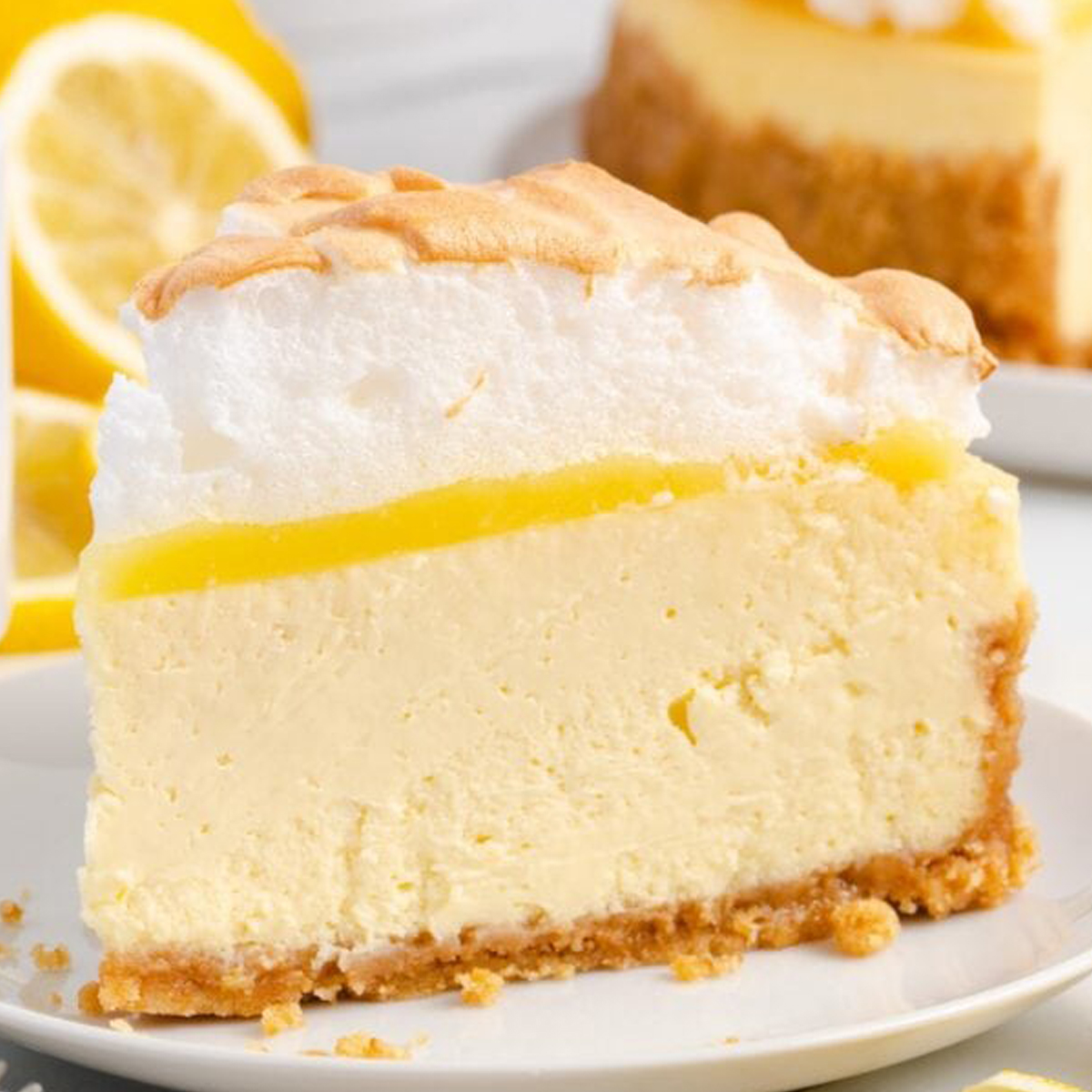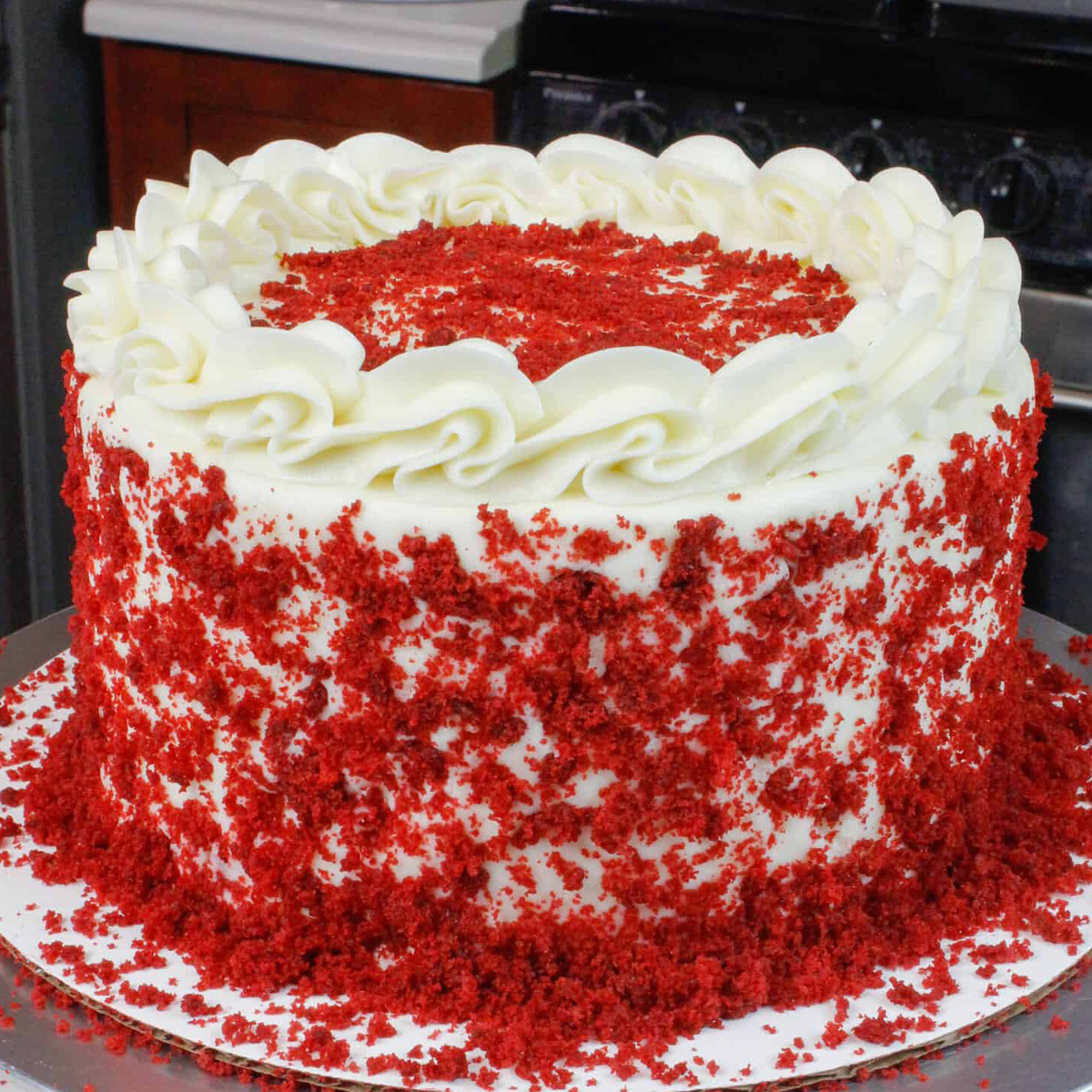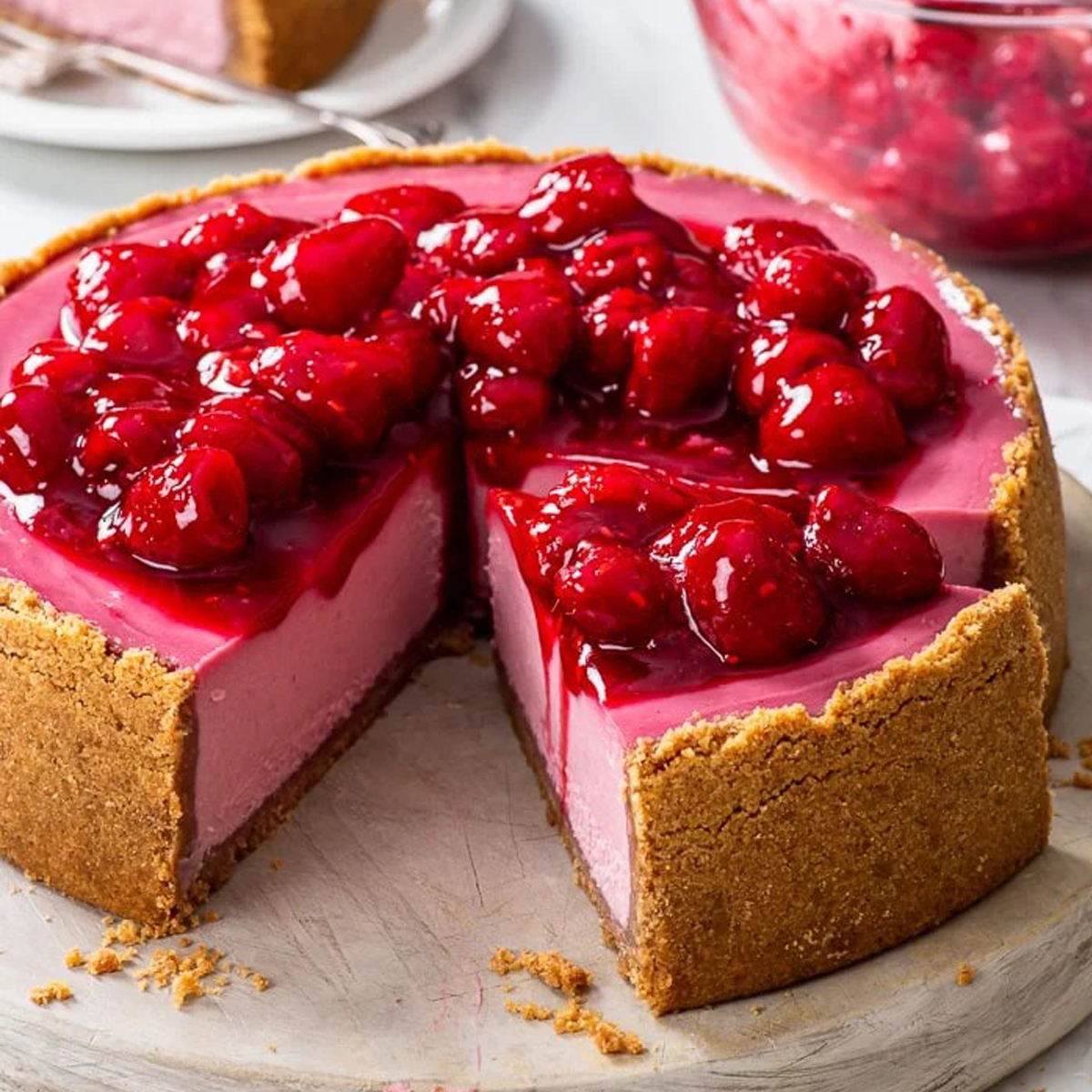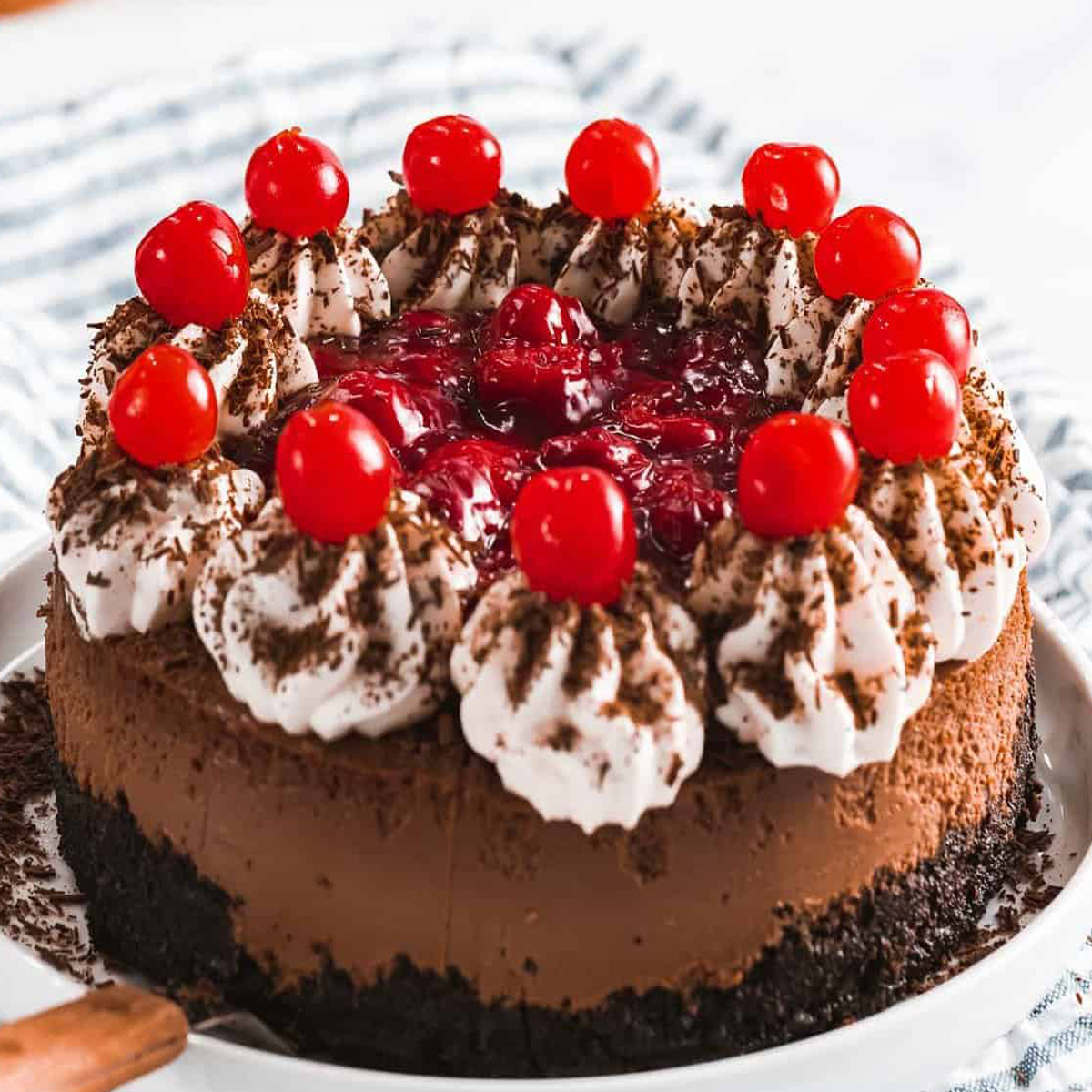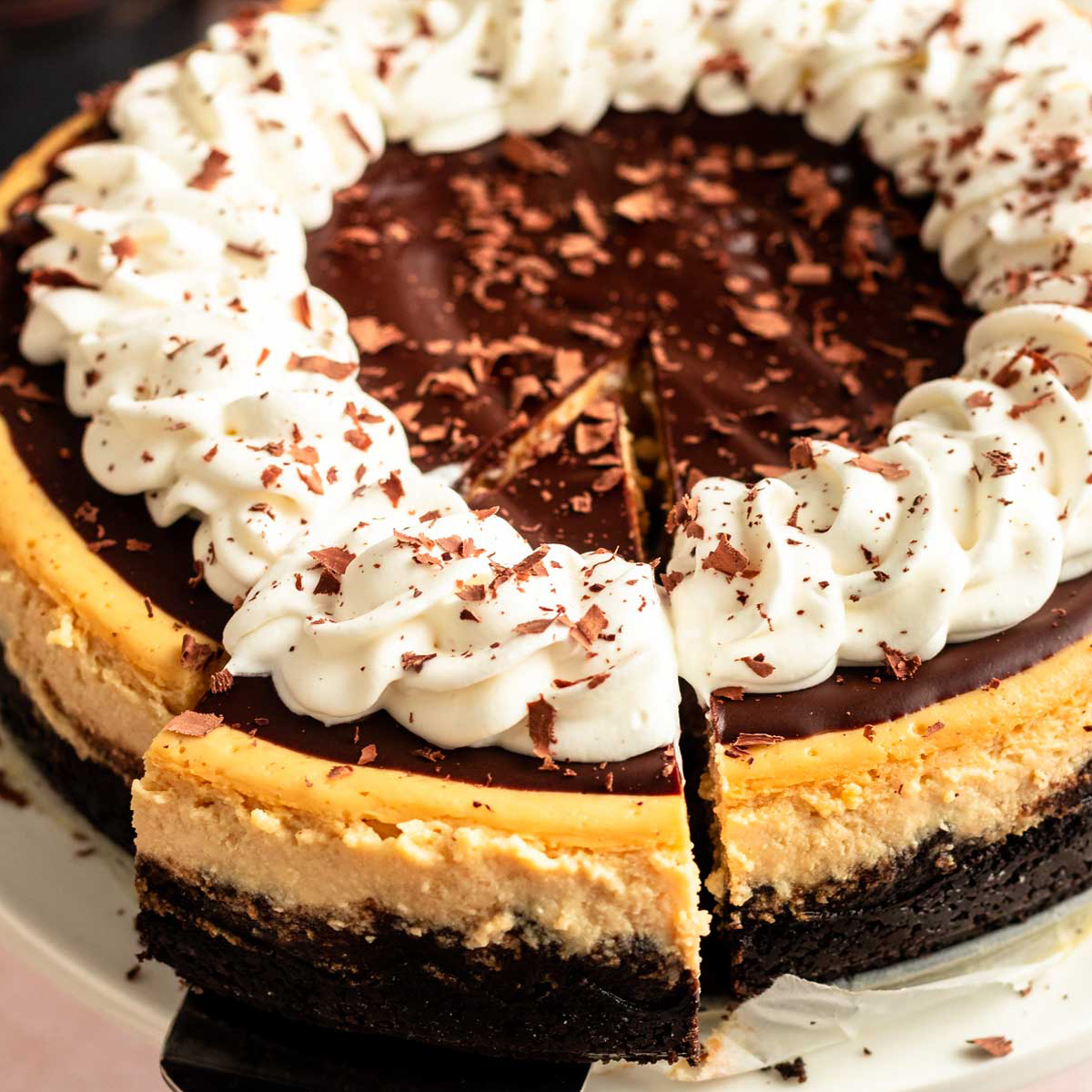Lemon Meringue Cheesecake is a delightful and decadent dessert that combines the tangy zest of lemons with the creamy richness of cheesecake, all crowned with a fluffy and lightly toasted meringue topping. This dessert is a fusion of two beloved classics, lemon meringue pie and traditional cheesecake, resulting in a mouthwatering treat that’s sure to please even the most discerning taste buds. The zesty lemon flavor provides a refreshing contrast to the velvety smoothness of the cheesecake, while the meringue topping adds a delightful textural element and a touch of sweetness. Whether you’re a fan of citrusy desserts or simply looking to indulge in a dessert that marries the best of both worlds, Lemon Meringue Cheesecake is a delectable choice for any occasion.

What is Lemon Meringue Cheesecake?
Lemon Meringue Cheesecake is a delicious dessert that combines the flavors and elements of lemon meringue pie with traditional cheesecake. It typically consists of three main components:
- Crust: The base of the cheesecake is often made from crushed graham crackers or digestive biscuits mixed with melted butter and sometimes a touch of sugar. This mixture is pressed into the bottom of a springform pan to create a firm and slightly sweet crust.
- Cheesecake Filling: The cheesecake filling is a creamy and tangy mixture made primarily from cream cheese, sugar, eggs, and lemon zest or lemon juice. The lemon zest or juice provides the characteristic lemon flavor. The cheesecake filling is poured over the crust and baked until it sets, resulting in a rich and creamy layer.
- Meringue Topping: To mimic the meringue topping of a traditional lemon meringue pie, a layer of sweet meringue is added to the baked and cooled cheesecake. Meringue is typically made from egg whites and sugar, beaten until stiff peaks form. This fluffy meringue layer is spread or piped on top of the cheesecake and can be browned slightly with a kitchen torch or by briefly returning it to the oven.
The combination of the creamy cheesecake filling with the tartness of the lemon flavor and the sweet, fluffy meringue topping creates a delightful contrast in taste and texture. It’s a popular dessert choice for those who enjoy the bright and zesty taste of lemon paired with the richness of cheesecake.

Why you will love Lemon Meringue Cheesecake?
- Flavor Contrast: Lemon Meringue Cheesecake offers a delightful combination of flavors. The tangy and zesty lemon flavor in the filling contrasts beautifully with the creamy richness of the cheesecake and the sweet, fluffy meringue topping. This combination of sweet, tart, and creamy flavors can be very appealing to the palate.
- Textural Variety: This dessert also provides a satisfying textural experience. The crunchy and slightly sweet crust, the smooth and creamy cheesecake layer, and the airy meringue topping create a pleasant contrast in textures that many people find enjoyable.
- Visual Appeal: Lemon Meringue Cheesecake is often a visually stunning dessert. The golden-brown meringue topping can be beautifully browned and slightly caramelized, making it an attractive centerpiece for any dessert table or special occasion.
- Versatility: It’s a dessert that can be enjoyed year-round and is suitable for various occasions, from family gatherings to holiday celebrations. Its versatility makes it a popular choice for dessert lovers.
- Nostalgia: For those who have fond memories of enjoying lemon meringue pie or traditional cheesecake, Lemon Meringue Cheesecake can evoke a sense of nostalgia while offering a new and exciting twist on these classic desserts.
- Customization: Cheesecake recipes are often customizable, allowing individuals to adjust the level of lemon flavor, sweetness, and other ingredients to suit their personal preferences. This adaptability can make it a dessert that’s tailored to individual tastes.
In summary, Lemon Meringue Cheesecake is loved by many for its harmonious blend of flavors, pleasing textures, visual appeal, and the sense of nostalgia it can evoke. If you enjoy the combination of lemon, cheesecake, and meringue, this dessert is likely to be a delightful treat for you.

Lemon Meringue Cheesecake Recipe
Ingredients:
For the Crust:
- 1 1/2 cups (about 150 grams) graham cracker crumbs
- 1/4 cup (55 grams) granulated sugar
- 1/2 cup (115 grams) unsalted butter, melted
For the Cheesecake Filling:
- 4 packages (32 ounces total) cream cheese, softened
- 1 1/2 cups (300 grams) granulated sugar
- 4 large eggs
- Zest of 2 lemons
- 1/4 cup fresh lemon juice (about 2-3 lemons)
- 1 teaspoon vanilla extract
For the Meringue Topping:
- 4 large egg whites
- 1 cup (200 grams) granulated sugar
- 1/2 teaspoon cream of tartar
Instructions:
1. Preheat the Oven:
- Preheat your oven to 325°F (160°C). Grease a 9-inch (23 cm) springform pan with butter or cooking spray.
2. Prepare the Crust:
- In a mixing bowl, combine the graham cracker crumbs, 1/4 cup of sugar, and melted butter. Mix until the crumbs are evenly coated with butter.
- Press the crumb mixture firmly into the bottom of the prepared springform pan to form the crust. Use the back of a spoon or a flat-bottomed glass to ensure it’s compact and even.
- Bake the crust in the preheated oven for about 10 minutes. Remove and let it cool while you prepare the filling.
3. Make the Cheesecake Filling:
- In a large mixing bowl, beat the softened cream cheese and 1 1/2 cups of sugar together until smooth and creamy.
- Add the eggs one at a time, mixing well after each addition.
- Stir in the lemon zest, lemon juice, and vanilla extract until fully incorporated.
- Pour the cheesecake filling over the cooled crust in the springform pan.
4. Bake the Cheesecake:
- Place the springform pan on a baking sheet to catch any potential drips.
- Bake the cheesecake in the preheated oven for approximately 45-50 minutes, or until the edges are set, and the center is slightly jiggly.
- Turn off the oven and leave the cheesecake in the oven with the door ajar for about 1 hour to cool gradually.
5. Prepare the Meringue Topping:
- In a clean, dry mixing bowl, beat the egg whites until they are foamy.
- Add the cream of tartar and continue beating.
- Gradually add the sugar, one tablespoon at a time, while continuing to beat until stiff, glossy peaks form.
6. Top the Cheesecake with Meringue:
- Carefully remove the cheesecake from the springform pan.
- Spread or pipe the meringue over the cooled cheesecake, ensuring that it touches the edges of the crust to seal in the filling.
7. Brown the Meringue:
- Use a kitchen torch to lightly brown the meringue, giving it a beautiful caramelized finish.
8. Chill and Serve:
- Refrigerate the cheesecake for at least 4 hours, or overnight, to allow it to set.
- Slice and serve your delicious Lemon Meringue Cheesecake.
Enjoy your homemade Lemon Meringue Cheesecake!

How to serve Lemon Meringue Cheesecake
Serving Lemon Meringue Cheesecake is a delightful experience, and you can make it even more enjoyable with a few tips on presentation and accompaniments. Here’s how to serve Lemon Meringue Cheesecake:
- Chill Well: Before serving, make sure your cheesecake has been adequately chilled. This helps the flavors meld and ensures that the cheesecake is firm and holds its shape when sliced.
- Slice Carefully: Use a sharp, clean knife dipped in hot water and wiped dry between each cut to ensure clean and smooth slices. This prevents the cheesecake from sticking to the knife and maintains its appearance.
- Garnish: Consider garnishing each slice with a few additional touches to enhance the presentation and flavor. Some popular garnishes for Lemon Meringue Cheesecake include:
- Fresh Lemon Zest or Slices: A few curls or slices of lemon zest on top of each slice add a burst of color and extra lemon flavor.
- Whipped Cream: A dollop of freshly whipped cream on the side or on top of the cheesecake complements the richness of the dessert.
- Fresh Berries: A handful of fresh berries, such as strawberries, blueberries, or raspberries, can add a pop of color and a refreshing contrast to the sweetness of the cheesecake.
- Serve Cold: Lemon Meringue Cheesecake is best enjoyed when it’s cold. Serve it straight from the refrigerator or a chilled dessert plate to maintain its creamy texture.
- Accompaniments: While the cheesecake is delicious on its own, you can consider serving it with some additional accompaniments if desired. A small drizzle of raspberry sauce, a sprinkle of powdered sugar, or a scoop of vanilla ice cream can all be delightful choices.
- Plating: Present each slice on a dessert plate or a decorative serving platter. You can also dust the plate with a little powdered sugar or cocoa powder for an elegant touch.
- Enjoy! Encourage your guests to savor each bite of the Lemon Meringue Cheesecake, appreciating the contrast of flavors and textures.
Remember to store any leftover cheesecake in the refrigerator to maintain its freshness. With these serving tips, you can make your Lemon Meringue Cheesecake not only delicious but also visually appealing for your guests to enjoy.

How to store Lemon Meringue Cheesecake
Proper storage is essential to keep your Lemon Meringue Cheesecake fresh and safe to eat. Here’s how to store it:
- Cool Completely: Allow the Lemon Meringue Cheesecake to cool completely at room temperature for about an hour after you have finished serving it. This helps prevent condensation from forming inside the storage container.
- Refrigeration: The best way to store a cheesecake is in the refrigerator. Cover the cheesecake with plastic wrap or aluminum foil to protect it from drying out or absorbing odors from the fridge. Make sure the wrapping is tight and covers the entire surface.
- Use an Airtight Container: If you have one large enough, you can also store the cheesecake in an airtight container with a secure lid. This helps maintain the freshness and prevents any potential damage to the top from the wrapping.
- Individual Slices: If you plan to store individual slices, wrap each slice separately in plastic wrap or place them in airtight containers. This makes it easier to grab a portion as needed without exposing the entire cheesecake to air.
- Avoid Odor Transfer: Be mindful of strong-smelling foods in the refrigerator. Cheesecake can absorb odors, so try to store it away from items like onions, garlic, or strongly flavored cheeses.
- Position Carefully: Ensure that the cheesecake is stored on a flat and stable surface in the refrigerator to prevent it from tilting or getting damaged.
- Consume Within a Few Days: Cheesecake is best when consumed within 3-4 days of making it, although it may stay safe to eat for up to a week if stored properly.
- Freezing (Optional): If you need to store the cheesecake for an extended period, you can freeze it. Wrap the whole cheesecake or individual slices tightly in plastic wrap and then aluminum foil to prevent freezer burn. Store it in an airtight container or a freezer-safe zip-top bag. Frozen cheesecake can be stored for up to 1-2 months.
- Thawing: When you’re ready to enjoy a frozen cheesecake, transfer it to the refrigerator and allow it to thaw overnight. This gradual thawing process helps maintain the cheesecake’s texture.
Remember that while storing cheesecake in the freezer can preserve it for longer, there may be some texture changes upon thawing. The texture may not be as creamy as when it was freshly made, but the flavor should still be good.
By following these storage guidelines, you can ensure that your Lemon Meringue Cheesecake remains fresh and delicious for as long as possible.
Other Delicious Dessert Recipes To Try
- The Perfect Baileys Cheesecake
- Black Forest Cheesecake Magic
- Berrylicious Raspberry Cheesecake
- Chocolate Orange Cheesecake Indulgence
Tips to make perfect Lemon Meringue Cheesecake
Making a perfect Lemon Meringue Cheesecake can be a delightful culinary experience. Here are some tips to help you achieve the best results:
For the Crust:
- Choose the Right Pan: Use a high-quality, non-stick springform pan for easy removal and to prevent the crust from sticking.
- Even Crust Thickness: When pressing the crust into the pan, ensure it’s evenly distributed and pressed firmly to the bottom. Use the back of a spoon or a flat-bottomed glass to achieve an even layer.
- Prebake the Crust: Prebaking the crust for a few minutes before adding the filling helps it set and prevents it from becoming too soggy when the cheesecake is baked.
For the Cheesecake Filling:
- Room Temperature Ingredients: Make sure your cream cheese, eggs, and other dairy ingredients are at room temperature before mixing. This ensures a smoother and creamier filling.
- Mix Thoroughly but Don’t Overmix: Blend the cream cheese and sugar until smooth, but avoid overmixing once you add the eggs. Overmixing can lead to cracking in the cheesecake.
- Lemon Flavor: Use fresh lemon zest and juice for the best lemon flavor. Avoid bottled lemon juice for a fresher taste.
- Use a Water Bath (Optional): To prevent cracking, consider baking your cheesecake in a water bath. Wrap the bottom of the springform pan with heavy-duty aluminum foil to keep water from seeping into the pan.
For the Meringue Topping:
- Clean Equipment: Ensure your mixing bowl and beaters for the meringue are completely clean and free of any grease or residue. Even a small amount of fat can prevent the egg whites from whipping properly.
- Stiff Peaks: Whip the egg whites until stiff peaks form. The meringue should be glossy and hold its shape.
Assembly and Baking:
- Cool Gradually: After baking, turn off the oven and leave the cheesecake inside with the oven door slightly ajar for about an hour. This gradual cooling helps prevent cracks.
- Refrigerate Before Topping: Allow the cheesecake to chill in the refrigerator for a few hours or overnight before adding the meringue topping. A cold cheesecake is easier to work with and helps the meringue set nicely.
- Apply Meringue Carefully: When spreading or piping the meringue on top of the cheesecake, ensure it touches the edges of the crust to create a seal. This helps prevent the meringue from shrinking away from the edges during baking.
- Browning the Meringue: Use a kitchen torch to brown the meringue evenly. Hold the torch about 2 inches (5 cm) away from the surface and move it in a circular motion for an attractive finish.
Serving:
- Slice with Care: When slicing, use a sharp knife dipped in hot water and wiped dry between each cut to achieve clean and neat slices.
By following these tips and paying attention to details, you can create a perfect Lemon Meringue Cheesecake that is not only visually stunning but also deliciously creamy and full of zesty lemon flavor.

FAQ’s
- Can I use store-bought lemon curd for the topping instead of making meringue?
- Yes, you can use store-bought lemon curd as a quick and convenient alternative to making meringue. Simply spread a layer of lemon curd over the chilled cheesecake before serving.
- Can I make a no-bake Lemon Meringue Cheesecake?
- Yes, you can make a no-bake version by using a no-bake cheesecake filling recipe and adding the lemon flavor. Simply mix the cheesecake ingredients with lemon zest and juice and refrigerate until set, then add the meringue topping.
- How can I prevent my cheesecake from cracking?
- Avoid overmixing the cheesecake batter, use room temperature ingredients, and consider using a water bath during baking. Gradually cooling the cheesecake in the turned-off oven also helps prevent cracks.
- My meringue didn’t brown evenly. What should I do?
- Ensure that you hold the kitchen torch at a consistent distance from the meringue while browning. Moving it in a circular motion helps achieve even browning. If some areas remain un-browned, you can touch them up with the torch carefully.
Troubleshooting:
- My cheesecake turned out lumpy. What went wrong?
- Lumpy cheesecake can result from overmixing or using cold ingredients. Mix the filling just until smooth, and make sure all dairy ingredients are at room temperature.
- The meringue collapsed after baking. How can I prevent this?
- Overwhipping the meringue can cause it to collapse during baking. Whip the egg whites to stiff peaks, but avoid overbeating. Also, ensure that the meringue is spread or piped onto the cheesecake while it’s hot.
- My cheesecake stuck to the pan. How can I prevent this?
- To prevent the crust from sticking to the pan, you can line the bottom with parchment paper before adding the crust mixture. Additionally, running a thin knife around the edge of the cheesecake after it has cooled can help release it from the pan.
- The meringue topping weeps or becomes watery. What caused this?
- Weeping meringue is often the result of undercooking or overcooking it. Ensure that the meringue reaches stiff peaks before topping the cheesecake, and use a kitchen torch to brown it evenly. Overcooking can cause the meringue to release moisture.
- My meringue topping turned grainy. What caused this and how can I fix it?
- Grainy meringue can occur if the sugar doesn’t fully dissolve in the egg whites. Ensure that the sugar is added gradually while beating the egg whites and that it’s fully dissolved before topping the cheesecake.
By addressing these common questions and troubleshooting issues, you can increase your chances of successfully making a delicious and visually appealing Lemon Meringue Cheesecake.
Nutrition information
The nutritional information for Lemon Meringue Cheesecake can vary depending on the specific recipe, serving size, and ingredient brands used. Here’s a general estimate for a typical slice of Lemon Meringue Cheesecake (1/12th of a 9-inch cheesecake) without specific brand information:
- Calories: Approximately 350-400 calories per slice.
- Protein: About 6-8 grams.
- Carbohydrates: Approximately 30-40 grams.
- Dietary Fiber: 1-2 grams.
- Sugars: Around 20-25 grams.
- Fat: Approximately 23-30 grams.
- Saturated Fat: About 13-18 grams.
- Cholesterol: Approximately 70-90 milligrams.
- Sodium: Around 250-300 milligrams.
Please note that these are rough estimates and can vary significantly based on factors such as the exact ingredients used, the portion size, and any modifications to the recipe. Additionally, nutritional information may change if you choose to use low-fat or reduced-sugar alternatives in your recipe.
If you have specific dietary restrictions or are concerned about the nutritional content of your Lemon Meringue Cheesecake, it’s a good idea to use a nutritional calculator or consult the packaging of your ingredients for more accurate information. You can also make adjustments to the recipe to meet your dietary needs, such as using lower-fat cream cheese or reducing the sugar content.

